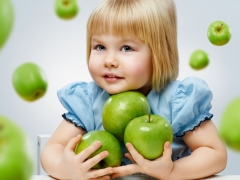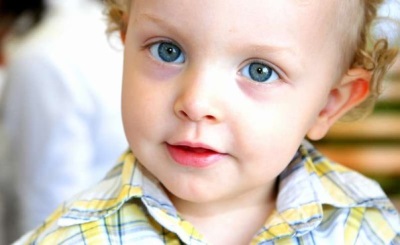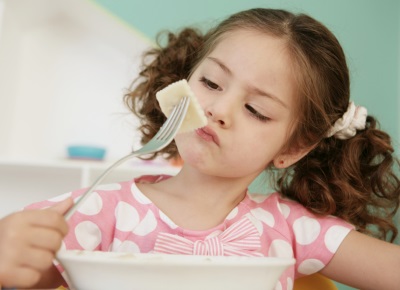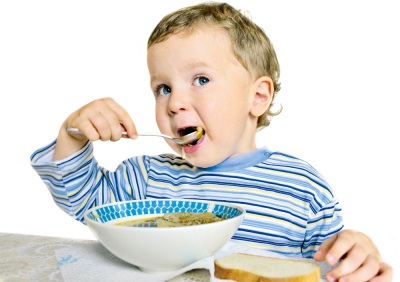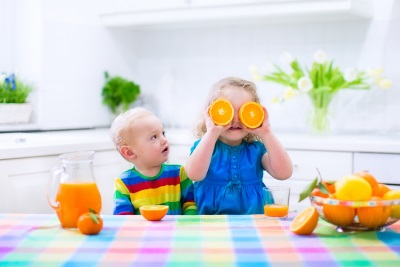Menu of a child in 3 years: principles of nutrition
A three-year-old child has almost completely switched to adult food, but there are still some limitations in his diet. Let's take a look at how to feed the babies at this age, how to prepare food and how to build an optimal diet that covers all the needs of the child.
Principles of proper nutrition
The opinion that a child should be monitored only until the age of 3, and then the baby can be allowed to eat anything, is erroneous. Rational nutrition is important for children who have stepped over a three-year milestone, no less than for children 1-2 years of age. It provides such nuances:
- All food for a child of three years can be divided into consumed daily and consumed occasionally. The products that the crumb needs every day include fruit, butter, bread, meat, vegetables, sugar and milk. Cottage cheese, fish, cheese and it is not necessary to give eggs daily - dishes from these products are prepared 1-3 times a week, while spending the entire weekly rate of the product.
- The distribution of calories during the day for a three-year-old child will be as follows: 25% for breakfast, 35-40% for lunch, 10-15% for snack and 25% for dinner.
- With regard to macronutrients, special attention in the child's diet should be given to the intake of animal proteins (they should be at least 2/3 of the total amount of proteins in the diet) and vegetable fats (they should be at least 15% of the total amount of fats).
- As for carbohydrates, in the diet of a 3-year-old child should be at least 3% of fiber and pectin substances that the baby receives from fruits and vegetables.
- Seasonings and spices are added to the dishes for a three-year-old child in small quantities. Allowed is the rare use of canned and dried foods.
The needs of a child in 3 years
Three-year-old children move a lot, grow actively and need quality sources of both energy and plastic material. After 3 years, the child needs approximately 1500-1800 kcal per day. The amount of protein and fat in the daily diet of a three-year-old baby should be about the same, and carbohydrates should be 4 times more than any of these nutrients.
For specific products, the needs of a three-year-old child are:
- A child should consume a variety of vegetables up to 500 g per day, and the potato should be no more than 1/2 of this amount.
- Fresh fruit is recommended to use 150-200 g per day.
- Vegetable or fruit juice should be drunk in a volume of 150-200 ml per day.
- Cereals, pasta and legumes for a three-year-old child are given in an amount of up to 50 g per day. Porridges begin to cook not viscous, but crumbly.
- The maximum amount of sugar and confectionery products that contain it (marmalade, marshmallow, marshmallow, jam) in the diet of a 3-year-old baby is 50-60 g. At the age of 3, it is permissible to start making chocolate.
- Bread of different varieties of the child should eat in the amount of 150-170 g per day (rye bread is recommended at least 50-60 g).
- Meats for a child can be consumed up to 90 g per day, fish - up to 50 g.
- A three-year-old child eats eggs every other day for 1 piece or 1/2 a day.
- Dairy products (among them - milk, kefir, yogurt, ryazhenka and others) should be received per day up to 500 g.
- In the menu of the child there can be not sharp hard cheese (it can also be melted) in the amount of up to 15 g per day.
- Cottage cheese is limited to 50 grams per day.
- Vegetable oil is added to different dishes for a child in the amount of 6 g per day.
- Animal fats in the diet can be represented with butter (it is advised to consume up to 17 g per day, adding to porridge and bread) and sour cream (add up to 15 g daily in different dishes).
- Margarine can only be used in the preparation of homemade baking.
- Flour products are limited to 100 g per day.

What kind of drinks can I give?
Kids of this age are given fresh juice, a compote of fresh, dried and frozen fruits, special juice for children, drinking water, dogrose broth, jelly, coffee substitute, tea. At the same time, tea for a three-year-old child is made weak and preferably with milk. Once or twice a week, children of this age make cocoa.
What can not be included in the diet?
Three-year-olds are not given:
- Smoked meats.
- Products with artificial colors, preservatives and other additives.
- Fatty meats.
- Spicy dishes.
- Mushrooms
Diet
Schooling a child to a particular diet helps to improve the digestion of food, since its digestive tract will produce digestive juices for the next meal. Hot food should be given to a child three times a day. There are 4 meals in total at three years of age, and the breaks between them should be about 4 hours (the maximum allowed break is 6 hours). It is recommended to give the baby food every day at the same time, deviating a maximum of 15-30 minutes. In between meals, you should not allow your child to have snacks in sweets.
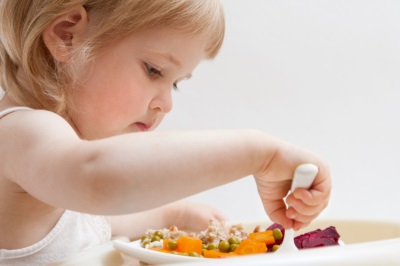
What are the best ways to cook?
From the age of three, it is permissible for a child to be given fried food, but preference should be given to previously used food processing methods - cooking, stewing, baking. Unlike cooking for adults, preschool children cook meat longer (up to two hours), and fish less (up to 20 minutes).
Prolonged processing of vegetables impairs their mineral and vitamin composition, so boil potatoes, carrots, and cabbage for no longer than 25 minutes, and beets for 1 hour.
How to make a menu for a three year old child?
- In the diet of a child of three years the range of dishes is already quite large. For children, they cook stews, stuffed and fried vegetables, various fish dishes, puddings, and casseroles. Dishes from legumes and meat are given in the first half of the day due to their long digestion.
- The volume of one meal for a 3-year-old child increases to 350-400 ml, and the total daily volume of food - up to 1500 g.
- For breakfast, the child is given a main course (porridge, noodles, egg dishes or from cottage cheese) in an amount of 250 g. A kid’s sandwich and drink in a volume of 150 ml are offered to him.
- Lunch begins with a snack, which most often is a vegetable salad and weighs about 50 g. First dishes are given in a volume of 200-250 ml. On the second offer a meat dish weighing 70-90 g (twice a week, replace with fish) and 110-130 g of garnish. Also, the child’s lunch should include bread (up to 80 g) and a drink (juice, compote, jelly) 150 ml.
- For an afternoon snack, a three-year-old child is offered kefir or yoghurt in a volume of 200 ml, to which cookies (25 g) or homemade pastries are given.
- Dinner includes a main dish weighing 200 g, a drink of 150 ml and bread up to 40 g. Milk-vegetable dishes are considered the best food for dinner, as they are easily digested.
- In drawing up the menu, you need to make sure that the same dish does not repeat at the same day in different meals. For example, if the side dish for lunch was cereal, then dinner is better to make vegetables.
- In the cold season, the child can be offered more cereal and bread, and during the hot season - more fruit dishes and vegetables.
Sample weekly menu
A three-year-old child can eat according to the following menu:
Day of the week | Breakfast | Dinner | Afternoon tea | Dinner |
Monday | Oatmeal with fruit (250 g) Bread and butter (30 g / 10 g) Milk (150 ml) | Salad from pumpkins and apples (50 g) Borsch (200 ml) Zrazy from fish with egg (70 g) Boiled rice (110 g) Apple compote (150 ml) Bread (80 g) | Kefir (200 ml) Cookies (25 g) Fresh Apple (50 g) | Potato casserole with cabbage (200 g) Bread (40 g) Rosehip Infusion (150 ml) |
Tuesday | Omelette (50 g) Milk buckwheat porridge (200 g) Bread and butter (30 g / 10 g) Cocoa with milk (150 ml) | Boiled green peas (50 g) Noodle broth (200 ml) Vegetable stew (110 g) Beef Stew (70 g) Pear Compote (150 ml) Bread (80 g) | Yogurt (200 ml) Milk cake (50 g) | Stewed Liver (50 g) Buckwheat porridge (150 g) Bread (40 g) Kissel (150 ml) |
Wednesday | Cheesecakes with sour cream (250 g) Bread and butter (30 g / 10 g) Milk (150 ml) | Carrot Salad (50 g) Borsch (200 ml) Stewed vegetables (120 g) Beef stroganoff from boiled meat (70 g) Bread (80 g) Rosehip Infusion (150 ml) | Ryazhenka (200 ml) Baked Apple (60 g) Cookies (25 g) | Omelette (50 g) Milk rice porridge (150 g) Bread (40 g) Tea with milk (150 ml) |
Thursday | Rice porridge with apple (250 g) Bread with cheese (30 g / 10 g) Tea with milk (150 ml) | Beetroot Salad (50 g) Souppumpkin puree (200 ml) Chicken chops (70 g) Cauliflower puree (120 g) Bread (80 g) Apple Juice (150 ml) | Kefir with berries (200 ml) Cookies (25 g) | Potato zrazy with turkey (200 g) Bread (40 g) Tea with milk (150 ml) |
Friday | Milk vermicelli (250 g) Bread and butter (30 g / 10 g) Tea with honey (150 ml) | Cabbage and carrot salad (50 g) Fish soup (200 ml) Mashed potatoes (110 g) Carrot and apple juice (150 ml) Bread (80 g) | Kissel (200 ml) Curd Pie (50 g) | Stewed vegetables (200 g) Bread (40 g) Kefir (150 ml) |
Saturday | Milk semolina with strawberries (250 g) Bread with cheese (30 g / 10 g) Cocoa with milk (150 ml) | Beetroot (200 ml) Buckwheat porridge (110 g) Rabbit cutlets (70 g) Bread (80 g) Compote from dried apples (150 ml) | Milk (200 ml) Homemade bun with raisin (50g) | Potato and vegetable casserole (200 g) Bread (40 g) Kefir (150 ml) |
Sunday | Grated carrots with sugar (50 g) Cottage Cheese Casserole (200 g) Bread and butter (30 g / 10 g) Tea with milk (150 ml) | Cucumber and Tomato Salad (50 g) Soup with chicken meatballs (200 ml) Mashed potatoes and cauliflower (120 g) Berry Compote (150 ml) Bread (80 g) | Kefir (200 ml) Cottage Cheese Cookies (25 g) | Rice casserole with dried apricots (200 g) Bread (40 g) Strawberry jelly (150 ml) |
Examples of useful recipes
Radish and egg salad
Wash and clean 50 grams of radish, cut into thin slices. Cut half of hard-boiled eggs, combine with radish, add 10 g of sour cream and salt a little. Sprinkle with fresh dill on top.
Meatloaf stuffed with carrots and rice
Sort and wash 10 g of rice, boil until tender. Peel 50 grams of carrots, grate and stew together with 5 grams of finely chopped onion until half cooked. Mix rice, onions, carrots and half a hard-boiled and diced chicken egg. Take 100 g of minced meat, put it on a chopping board moistened with water. Putting the rice-carrot stuffing inside, make a roll with wet hands, turn the seam down and bake in the oven for about 40 minutes. Shortly before the end of cooking grease roll 10 g sour cream.
Soup with fish and potatoes
Stew in butter (5 g) finely chopped onions (10 g), parsley root (5 g) and carrots (10 g). Bring to a boil 250 ml of fish broth, place vegetables in it, add diced potato (100 g) and cook for 20 minutes. When serving soup on the table, put 70 g of boiled fish in a plate and sprinkle it with chopped dill.
Liver-Stewed Vegetables
Peel off the films and cut 100 g of liver into pieces. Wash and shred 20 g cabbage, 20 g carrots and 10 g onions. Put chopped liver in a baking dish, and above - vegetables, salt, cover with milk and put in the oven for 30 minutes.
Heart Beat
Pass through a meat grinder 70 g of the heart, add 5 g of semolina, 30 ml of water and mix. Make chops from the resulting mince, roll them in flour and fry a little, then bring to the readiness in the oven.
Calamari stewed with vegetables
Cut 100 g white cabbage, 10 g onions and 10 g carrots. Stew vegetables on low heat under a lid for 30 minutes, add 10 g of tomato paste and diced 50 g of squid. Simmer for another 10 minutes.
Cabbage Casserole
Cut 100 g of cabbage, cover with 40 ml of milk and simmer until soft. Pour 10 g of semolina into the cabbage and, while stirring, simmer another 10 minutes.Add to the resulting cabbage mass one hard-boiled quail egg, which must be chopped. After transferring the mass into a buttered baking dish, grease 15 g of sour cream on top. Bake until done, serve with sour cream.
Curd and noodle casserole
Boil and strain 50 g of noodles, combine with 50 g of cottage cheese, add a teaspoon of sugar and beaten with milk (40 ml) raw chicken egg (half). Put the curd with noodles in a baking dish, brush with sour cream on top and bake until done.
Cocoa
Mix 3 g of cocoa powder and 16 g of sugar, pour it into a saucepan, where 100 ml of milk and 100 ml of water are combined and heated to boiling. Bring to a boil again.
Possible problems
The most common nutritional problem for a child of three years old is poor appetite. Its reason is usually frequent snacks and indulgence of parents to the whims of the child in relation to different products. However, reduced appetite may also indicate a disease, for example, bowel pathology, nervous stress, or worm infestation.

If the child’s appetite is low, you should be the first to offer him a more nutritious meal (this is especially true for lunch, when eating meat and garnish is more important than soup). To improve digestion and increase appetite, cook for crumbs varied. You do not need to enter into its diet a lot of products, just expand the possible range of dishes from those products that the child does not refuse. For example, if a child eats beef burgers, offer him a souffle, goulash, roll, casserole with vegetables. You can also increase your appetite by using different sauces.
Also consider that there are situations when the child will not be hungry and at the same time will be healthy:
- Immediately after sleep.
- With negative emotions.
- At high temperatures in the room.
Tips
A child who goes to kindergarten should be given fruits, vegetables and protein foods from cottage cheese, meat and fish at home to supplement the food that the kid gets in the garden.
Consider the following nuances:
- From the age of 3, the child can begin to master the plug. Offer the baby a small fork with non-sharp teeth. Show your child how to cut food with this table item, and also how to recruit crumbly food.
- Do not sit down at the table of a child who has just returned from a walk or has played a mobile game. Let the baby calm down a bit and only then begin to eat.
- Teach your child hygiene, reminding you to constantly wash your hands before eating. You should also teach your child to etiquette behavior at the table. The best way to do this is to show it by example.
- Do not distract the child while eating. Remember that a 3-year-old baby cannot eat and talk at the same time.
- On weekends, try not to allow long breaks without food and not to encourage your child to use products that are unnecessary for him.
Vitamins for a child from 3 years give many parents. Is this necessary, read the other article.
